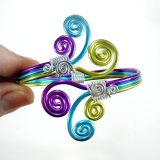How Do Screws Stay Tight?
Hey DIY champs! Let’s talk about screws – those unsung heroes that keep our world together. Ever wonder how these little things manage to stay tight and hold everything from your bookshelf to your sanity intact? It’s like they’re the tiny glue that keeps the universe from falling apart. So, grab your toolkit, and let’s unravel the magic behind the stay-put wonders we call screws.
The Basics: Threads, Threads, Threads
First things first, let’s get down to the nitty-gritty. Picture a screw – it’s not just a smooth rod; it’s got these groovy threads spiraling around it. Think of them as nature’s own Velcro. When you twist that screw into a material, these threads dig in, creating a tight grip. It’s like giving your screw a bear hug – those threads are doing all the heavy lifting to keep things snug.
Torque Talk: The Power of the Twist
Now, let’s talk torque. No, it’s not a sci-fi term; it’s the magic word for the twisty action you apply when tightening a screw. Imagine you’re turning a key to open a treasure chest – that’s the kind of twist we’re talking about. The torque you apply converts into a force that drives those threads into the material, securing the screw in place. It’s like a superhero spin, but for hardware.
Friction – The Unsung Hero
Ever notice how a jar lid can be a bit stubborn to open? That’s friction at play, my friend. Similarly, when you tighten a screw, friction comes into action. The threads create resistance against the material, preventing the screw from wiggling its way out. It’s like the unsung hero in the stay-tight saga – keeping things together by putting up a good fight against any unwanted spinning.
Material Matters: Choosing the Right Combo
Now, let’s talk compatibility. It’s like picking dance partners – some screws prefer a certain type of material to twirl around with. Wood screws, for example, are made for wood. They have sharp threads designed to bite into the wood fibers, creating a strong hold. Metal screws, on the other hand, have a different thread profile to navigate the tougher terrain of metal. So, matching the right screw with the right material is like a perfect dance duo – they just click.
Size Does Matter: Finding the Perfect Fit
In the world of screws, size matters – and no, we’re not talking about length envy. Using the right size screw for the job is crucial. If it’s too short, it won’t grab enough material, and if it’s too long, it might poke through the other side. It’s like Goldilocks finding the perfect porridge – not too hot, not too cold, but just right. The ideal screw size ensures a snug fit without causing any headaches.
The Mystery of Thread Pitch
Now, let’s throw a curveball – thread pitch. It’s like the spacing between the threads on a screw. Think of it as the rhythm of a dance. A finer thread pitch means more threads in the same distance, providing a tighter grip. Coarse thread pitches are like a waltz, allowing for quicker insertion but with a bit more wiggle room. Choosing the right thread pitch is like picking the right dance tempo – slow and steady or fast and lively.
The Jamming Effect: Beyond the Basics
Ever noticed how sometimes a screw seems to resist being tightened further? That’s the jamming effect, and it’s a bit like hitting a speed bump. When the threads get too snug, they can create resistance, making it challenging to turn the screw further. It’s like the screw saying, “Whoa, we’re good here – no need to go any tighter.”
FAQs – Because Curiosity Never Rests
Q1: Can I use any screw for any material?
Ideally, no. Different materials require different types of screws. Wood screws for wood, metal screws for metal – it’s like matchmaking for hardware. Using the right combo ensures a solid connection.
Q2: How tight should I make a screw?
Tight, but not Hulk-smashing tight. Over-tightening can damage the material or the screw itself. It’s like giving a high-five – firm enough to feel the connection but not so hard that it stings.
Q3: Why does a screw sometimes feel like it’s stuck and won’t tighten further?
That could be the jamming effect. If the threads are snug, they might resist further turning. It’s like a friendly reminder from the screw, saying, “We’re good here – no need to go any tighter.”
Q4: What happens if I use the wrong size screw?
Using the wrong size screw can lead to a weak or ineffective connection. Too short, and it won’t grip enough; too long, and it might poke through or damage the material. It’s like trying to fit a square peg into a round hole – it just won’t work.
Q5: Can I reuse screws after removing them?
Yes, you can reuse screws if they’re in good condition. Just make sure the threads are still sharp, and they haven’t been stripped or damaged during removal. It’s like bringing out your favorite dance shoes for another spin – as long as they’ve got the moves, they’re good to go.
















